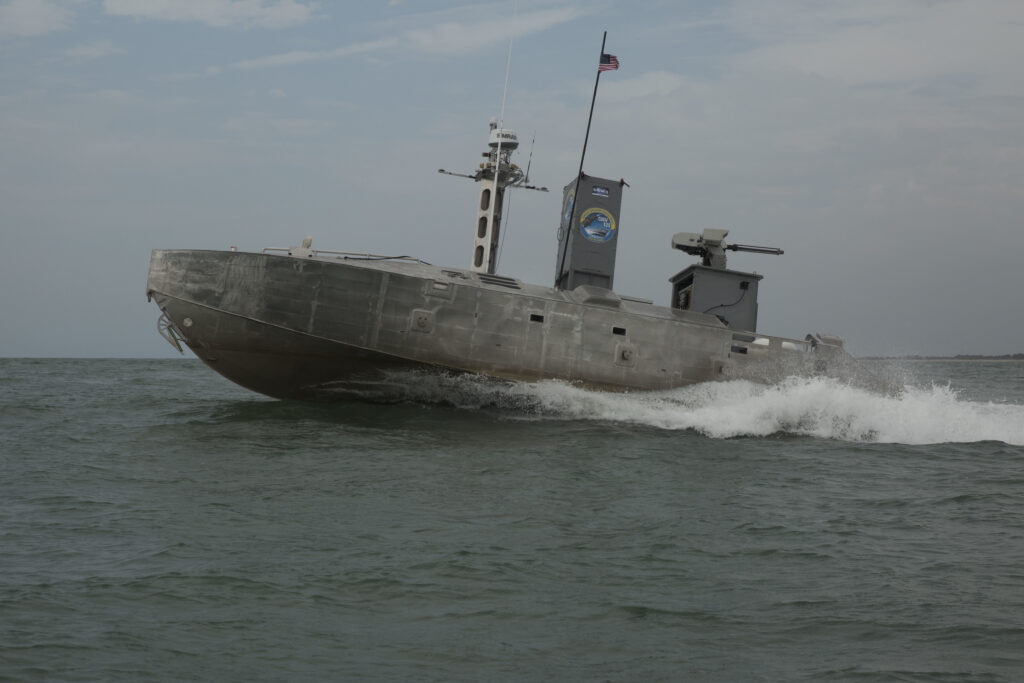
An Unmanned Surface Vessel navigates a set course at Camp Lejeune, July 2019.
WASHINGTON: The Navy and Marine Corps are testing radically new ways of operating in the Pacific by sending experimental unmanned ships into an ambitious exercise next week. Underpinning that exercise is an ambitious new plan for island-hopping that demands a fast implementation timeline.
On Monday, the Navy’s 3rd Fleet kicks off its first Unmanned Integrated Battle Problem 21 off the coast of California; a Zumwalt destroyer will command and control a variety of unmanned ships and aircraft.
Putting a variety of unmanned capabilities through their paces, “in a Pacific warfighting scenario,” Rear Adm. Robert Gaucher, Pacific Fleet’s director of maritime headquarters, said in a statement, the exercise “will include maneuvering in contested space across all domains, targeting and fires, and intelligence, reconnaissance and surveillance.”
The exercise will include the Super Swarm project, a secretive Office of Naval Research effort to operate swarms of small drones, and will see the MQ-8B Fire Scout UAV launched from a Littoral Combat Ship, as well as the MQ-9 Sea Guardian UAV. The Fire Scout and Sea Guardian will integrate with both Navy and Marine Corps units.
The exercise presages the standup of the Navy’s first-of-its-kind operational command to test and develop concepts for its new generation of unmanned surface vessels in 2022, a major step in getting autonomous ships into the fleet. Breaking Defense first reported the existence of the new command last month.
The Marines are busy with their own experimentation, and released their Tentative Manual For Expeditionary Advanced Base Operations this week, which will serve as a guidepost for their efforts to build new ways for island-hopping across the Pacific.
The document was first obtained by Breaking Defense earlier this month.
Marine Commandant Gen. David Berger has said he wants to see the first elements of EABO being put into practice by 2023, a quick turnaround “because that’s what he believes he owes the combatant commanders, the joint force commanders, in order to actually deter the pacing threat who’s constantly moving,” Lt. Gen. Eric Smith, the deputy commandant for combat development, told reporters this week. “He has given me no relief from that.”
Everything the Marines do from the Pacific to the Arctic over the next two years will have this new experimentation at its heart, Smith said: “Every time they go to the field, that’s an informal experiment with a radio, with a formation, with a command and control concept that all feeds back to the lab. So you will now start seeing a really rapid acceleration in the number of experiments, at all levels, small up to large.”
At its core, the 180-page document is intended to be the first step in an effort to create a series of small, agile units tasked with air defense, anti-ship and submarine warfare, and seizing, holding and resupplying small temporary bases as part of an island-hopping campaign in the Pacific in which units keep on the move, providing a more difficult target for enemy missile and aircraft.
On the equipment side, the assumptions signal a transformation in how the Marines outfit themselves, putting a range of new and developmental gear into the field quickly and at scale.
By 2030, the plan indicates that the Corps will have more than 100 Long Range Unmanned Surface Vessels in the fleet, performing surveillance and strike missions using small, armed, precision-guided drones capable of loitering over targets before crashing into them. It also calls for standing up new precision strike batteries armed with hundreds of Naval Strike Missiles, a powerful threat to hold enemy ships out of the 115 mile range of the missile.
Over the past two years, Berger has pushed for what are by far the most sweeping changes to the size and composition of his force among the services, and plans to do it all without asking for more money. Berger recently sent a memo to Defense Secretary Lloyd Austin advising him he will not request any more money in the 2022 budget.
To pay for this new equipment, Berger plans to divest of the Corps’ inventory of Abrams tanks and shed 12,000 Marines, along with towed artillery, aircraft and helicopters. He has also pledged to reduce the number of F-35s in squadrons while also questioning the role the aircraft will play in his plans going forward.






















